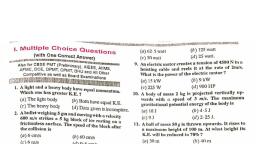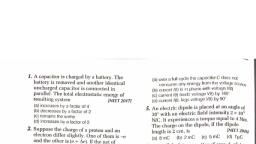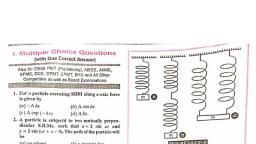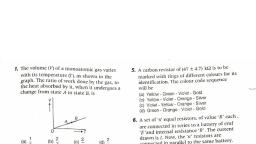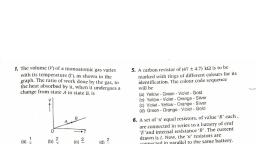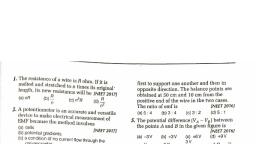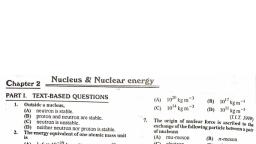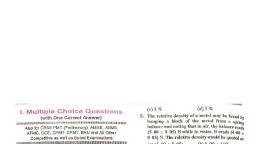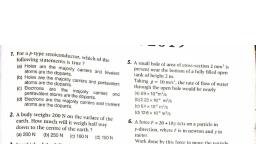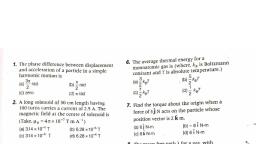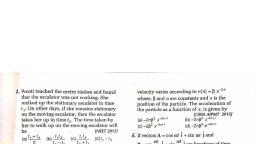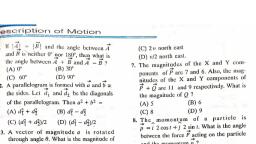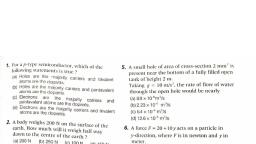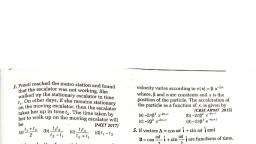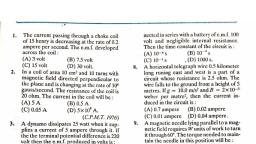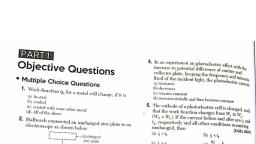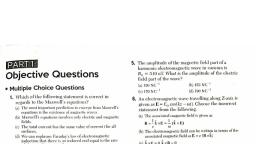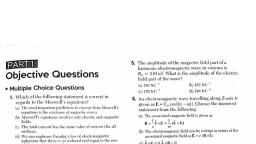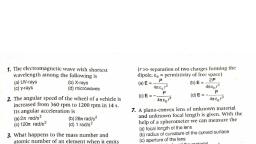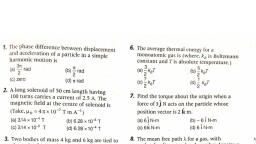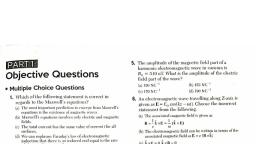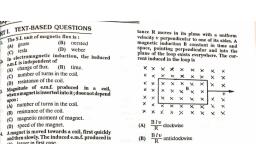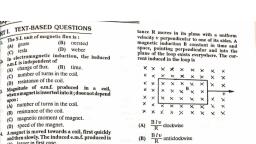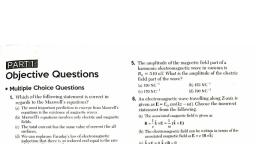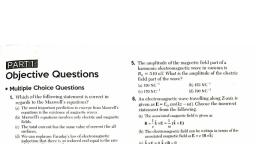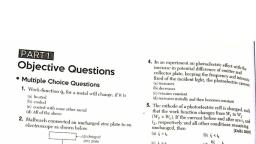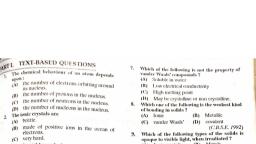Page 2 :
BEHAVIOUR OF PERFECT GXS AND KINETIC THEORY, , 4. For a diatomic gas; number of translational, , degrees of freedom is, (a4 oo, ©3 we, 5. For a gas, R/C, = 0-67, The pus is made up of, molecules, which are, (a) monoatomic (6) diatomic, (c) triatomic (d) polyatomic, 6. For water, molar specific heat is, (@)9R ()6R, (c)3R (@)4R, 7. The pressure P ofa gas and its, ones " a an mean K.E. per unit, es, (@)P=5E (b)P=E, (@P=3E @P=2n, , 8. The temperature of an ideal Bas Is increased fro:, mm, 120 K to 480 K. The rms velocity of gas molecules, , becomes, (a) half (6) double, (¢) quadrupled (d) cannot say, , 9. The average velocity of the molecules in a gas in, equilibrium is, , (a) « VT (6)=T, (c) « T? (d) cannot say, 10. A perfect gas at 27°C is heated nt constant pres, sure so as to double its volume. The temperature, of the gas will be, , (a) 300°C (6) 54°C, (ce) 600°C (4) 327°C, , 11. Three moles of oxygen are mixed with two moles, of helium. What will be the ratio of specific heats, at constant pressure and constant volume for the, mixture ?, , (a) 6-7 (b) 1-5, (c)4 (d) none of the above., 12, Four cylinders contain equal no. of moles of, , argon, hydrogen, nitrogen and carbon dioxide at, the same temperature. The energy Is minimum in, , (a) argon (b) carbon dioxide, (c) nitrogen (d) hydrogen., , 13, Avogadro’s number is the number of molecules in, (a) one litre of a gas at N.T-P.,, (b) one mole of a gas, _(c) one gram of a gas,, (d) one kg of a gas. (C.B.S.E.), , ‘ae,, , 14. An electric fan is switched on in closed rane, ‘The air in the room Is ., , (a) cooled (6) heated, (c) at constant room temperature, (d) heated or cooled depending. on atmos —, P1996, pressure. ;, , 15. The average translational energy 4nd the rms., speed of molecules in 0 sample of oxygen gas yt, , - 1, 300°K are 6-21 x 1077! J and 484 ms~* respec., tively. The corresponding values at 600K are, , nearly:, , (a) 12-42 x 1077! J; 968 ms?, , (6) 8-78 x 1072! J; 684 ms—?, , (c) 6-21 x 107745 ; 968 ms!, , (@) 12-42 x 1077" J; 684 ms,, 16. The average K.E. of a gas molecule at 27°C is, , 6-21 x 107?! J, Its average K.E. at 227° will be, , (a) 52-2 x 107213 (6) 5-22 x 107743, (c) 10-35 x 10774) (d) 11-35 x 107219, (P.M.T. MP. 1998), , 17. When the temp. of a gas filled in a closed vessel is, increased by 1°C, its pressure increases by 0-4, percent. The initial temperature of gas was, , (a) 250°C (b) 25°C, (c) 250K (a) 25K, (M.P.C.E,E. 1999), , (LLT. 1996), , 18. The K.E. of one mole of an ideal gas is E = 3 RT., Then C, will be, (2)0-SR (b/)O-1R, (c)1:5R (d)2-5R (A.M. 1999), 19. Oxygen and hydrogen gas are at same temp. and, , Pressure. And the oxygen molecule has 16 times, , the mass of hydrogen molecule. Then the ratio of, their r.m.s. speed is, , (p.c.E. 2092, , (a)2 (6) W/4, ©4 (2)16 (AM, 1999) 5, 20, If a gas has m degrees of freedom, ratio of prin: !, cipal specific heats of the gas is if, 2 i, (ayi+2 i448 !, (1-2 (d)1-F ;, 0, Cc
Page 4 :
2. The color code of a Tesistance is given belo, vw, , Yellow Violet Brown God, , The values of resistance, and tole, respectively, are rance, , (a) 47 KO, 10%, , (c) 470 2, 5% (0) 4.7 ki, 5%, , (d) 470 ka, 5%, , The capacitance of c|, , = with us as ty ioe ee, introduction of a dielectric medium, the, capacitance becomes 30 pF, The permittivity, of the medium is (ey = 8.85 x 107"? C?N7m"?), (a) 177 x 1072 C2N“ Wy?, (b) 044 x10" C*N“'r®, (c) 500 C?’N“m?, (044 x 40-3 C2N-“'m2, , 24, A ball is thrown vertically downward with a, velocity of 20 m/s from the top of a lower. It, hits the ground after some time with a velocity, of 80 m/s. The height of the tower is, (g =10 m/s?), (a)340m = (b) 320m, , 25. A body weighs 72 N on the surface of the, earth, What is the gravitational force on it, at, a height equal to half of radius of the earth?, , ()32N (0)S0N = (C)24N (0) 48N, , 26. Two particles of mass 5 kg and 10 kg, respectively are attached to the two ends ofa, , rigid rod of length | m with negligible mass., The centre of mass of the system from the, , 5 kg particle is nearly at a distance of, , (a) 50cm (b) 67 cm, , (c) 80. cm (d) 33 cm, , 27. The increase in the width of the depletion, region in a p-n junction diode is due to /, (a) reverse bias only ., (b) both forward bias and reverse bias, (c) increase in forward current, (d) forward bias only, , 28, Light of frequency 1-5 Himes the threshold, fmiency ‘e incident on a photosensitive, material, What will be the photoelectric, , (c) 300m = (d) 360m, , INLQL oViveu rapursvew, current if the frequency is halved and, intensity is doubled?, , (a) Four times, (c) Zero, , (b) One-fourth, {) Doubled, , 29, Assume that, light of wavelength 600 nm is, coming from a star. The limit of resolution of, telescope whose objective has a diameter of, 2mis, (a) 1.83 x 1077 rad, (c) GOO x 1077 rad, , (b) 7.32 «107 rad, (d) 366 x 10°” rad, , 30. A resistance wire connected in the left gap of, a metre bridge balances a 10 resistance in, the right gap at a point which divides the, bridge wire in the ratio 3 : 2. If the length of, the resistance wire is 1.5 m, then the length, of 1.Q of the resistance wire is, (a) 110x107" m (b) 15 x10"! m, (c) 15 «10% m (@) 10x 10% m, , 31. Light with an average flux of 20 wicm? falls, on a non-reflecting surface at normal, incidence having surface area 20 cm’, The, energy received by the surface during time, span of 1 min is :, (a) 12 x 10° J, (c) 48 x 10° J, , (b) 24 «10° J, (d) 10 x 10 J, , 32. Aray is incident at an angle of incidence i on, one surface of a small angle prism (with, angle of prism A) and emerges normally from, the opposite surface. If the refractive index of, the material of the prism is p, then the angle, of incidence is nearly equal to, , 2A pA A, a b) ey od, (a) - (b) pA (c) 3 (d) om, 33. A 40F capacitor is connected to a 200 V,, , 50 Hz AC supply. The rms value of the, current in the circuit is, nearly, , (a)2.05A (b)25A (C)25.1A (A)17A, 34, Dimensions of stress are ‘, (a) [ML2T-?} (b) (MLT~], (c) (ML“'T~?) (4) [(MLT"?}, , 35. The Brewster's angle i, for an interface, should be, (a) 30° <i, < 45¢, , b) 45° <i, < 90°, (0) /, = 90° (b) 6, , (d) 0°</, < 3°
Page 5 :
@ INEET Solved Paper 2uzu, , 36. A wire of length L, area of cross-section A is, hanging from a fixed support, The length of, the wire changes to L, when mass M is, suspended from its free end. The expression, for Young's modulus is, , , , Ma (ly -0) Mgt., (a) AL (b) AL,, Mgt Mat., tay (4, , 37. A short electric dipole has a dipole moment, of 16 x 10°? C-m. The electric potential due to, the dipole at a point at a distance of 0.6 m, , from the centre of the dipole, situated on a, line making an angle of 60° with the dipole, , axis is] 1 =9 x 10” Nm?/C?, 4ney, , (a)200V (6) 400V (ce) zero - «(c)50V, , 38, Ina guitar, two strings A and B made of, same material are slightly out of tune and, produce beats of frequency 6 Hz. When, tension in B is slightly decreased, the beat, frequency increases to 7 Hz. If the frequency, of A is 530 Hz, the original frequency of B, will be, (a) 524Hz (b)536Hz (c) 537 Hz, , 39, An electron is accelerated from rest through, a potential difference of V volt. If the, de-Broglie wavelength of the electron is, 1,227 x 107? nm, the potential difference is, , (a)107V— (b) 10°. (e) 10° (d) 10V, , 40. The solids which have the negative, temperature coefficient of resistance are, , (c) $23 Hz, , (a) insulator only, , (b) semiconductors only, , (c) insulators and semiconductors, (d) metals, , 41. The energy required to break one bord in, DNA is 102" J. This value (in eV) is nearly, , (a) 0.6 (b) 0.06 (c}0006 (dj) 6, , 42. The quantities of heat required to raise the, temperature of two solid copper spheres of, radii 7, and ry (f =1.5 7) through 1 K are in, , the ratio, , 5, 2 we ©f wz, , 43. Which of the following graph represents the, variation of resistivity (p) with temperature r), , , , , , for copper?, p Pp, (a) (b), T T, p p, « a) A, 7 r, , 44. For transistor action, which of the following, statements is correct?, (a) Base, emitter and collector regions should have, , same size., , (b) Both emitter junction as well as the collector, junction are forward biased., , (c) The base region must be very thin and lightly, doped., , (d) Base, emitter and collector regions should have, same dopping concentrations., , 45. For which one of the following, Bohr model, is not valid?, (a) Singly ionised helium atom (He* ), (b) Deuteron atom, (c) Singly ionised neon atom (Ne* ), (d) Hydrogen atom
